Abstract
This study aimed to examine students’ attitudes towards online shopping. The researcher strived to answer three key questions, which sought to find out students’ attitudes towards online shopping, the nationality of students who make the largest number of online purchases, and the barriers that prevent international students from embracing traditional and online shopping methods.
The researcher conducted the study at Liverpool International College (LIC) and the evidence showed that most students held a neutral view regarding online shopping. Comparatively, Chinese students emerged as being the most active users of online shopping platforms, while the time-consuming nature of traditional shopping and the extra costs associated with online shopping emerged as impediments to the growth of both commercial platforms.
Introduction
The growth of the internet has led to an increase in the number of young people who choose to buy goods online. According to Statista (2019), about 1.8 billion people buy goods virtually. The same statistics mirror the revenue generated from online shopping because different countries have recorded increased revenues from online purchases. For example, in the United States (US), online shopping generates about $2.8 trillion for local businesses, while projections show that this number could double to about $4.8 trillion in the year 2021 (Statista 2019). Comparatively, the United Kingdom (UK) is home to the third-largest online market globally because it generates about £533 billion in revenue (Statista 2018).
Statistics also show that about 87% of the UK population has bought an item online in the last year (Kitonyi 2017). In Europe, Norway is the only country that surpasses the UK in terms of online vibrancy of virtual sales (Kitonyi 2017). Globally, the US and China are the biggest players in the online retail sector (Kitonyi 2017). According to the UK Office of National Statistics, online sales are likely to increase by around 30% in the next few years (Kitonyi 2017).
Students are a major growth driver of this trend. However, few studies have focused on this demographic and how their attitudes influence the future performance of online shopping. This paper investigates the attitudes of international students in online shopping. Its findings will be instrumental in expanding the volume of literature regarding business-to-consumer (B2C) relationships and informing marketing decisions for retailers who target students as their main market. The aim and objectives of the study are highlighted below.
Research Aim
To examine students’ attitudes towards online shopping.
Research Objectives
- To find out the attitudes of international students towards online shopping,
- To establish the nationality of students who make the largest number of online purchases,
- To identify barriers that exist in traditional and online shopping for international students.
Research Questions
- What is the attitude of international students towards online shopping?
- What nationality of international students makes the largest number of online purchases?
- What are the barriers to traditional and online shopping for international students?
Hypotheses
- More than half of international students have a positive attitude towards online shopping.
- Chinese students make the largest number of online purchases.
- Lack of privacy and the time-consuming nature of online shopping are barriers to online and traditional shopping, respectively.
Literature Review
This section of the study will investigate what other researchers have written about the research topic. Notably, the section will contain an investigation regarding the attitudes of international students towards online shopping, the influence of different nationalities on online purchasing behaviors, and the barriers to traditional and online shopping.
Attitudes towards Online Shopping
In a quantitative study authored by Al-Debei, Akroush, and Ashouri (2015), researchers argued that trust significantly affected consumers’ attitudes towards online shopping. Trust is predicated on web quality because the higher the web quality, the more trusting customers become, and the more they are likely to have a positive attitude towards online shopping (Al-Debei, Akroush & Ashouri 2015).
Al-Debei, Akroush, and Ashouri (2015) developed these findings after sampling the views of 250 shoppers using a self-administered questionnaire. The researchers administered the questionnaires as a survey because of the large number of respondents involved (Al-Debei, Akroush & Ashouri 2015).
A Jordan-based study authored by Nabot, Garaj, and Balachandran (2017)also highlighted the role of trust in influencing consumer attitudes towards online shopping. The researchers gave the example of trust in e-retailers and online payment methods as being key drivers in the development of positive attitudes towards online shopping (Nabot, Garaj & Balachandran 2017). These findings were developed after sampling the views of 50 respondents using structured questionnaires. The researchers also used the survey technique because of the large number of respondents involved.
A different study conducted by Dani (2014) showed that web design and features influenced consumer attitudes towards online shopping. Dani (2014) also noted that many online shoppers use the virtual platform to buy goods because it saved them time and was convenient to use. Therefore, e-retailers that have integrated useful web design features on their websites have the best chances of succeeding in the online retail space.
Dani (2014) developed these findings after sampling the views of 100 respondents. He used the survey technique to collect the respondents’ views because the informants lived within a wide geographical radius.
In a different study authored by Kibet (2016), the researcher established that many people had a positive attitude towards online shopping. However, such an attitude depended on their awareness of online shopping techniques. Kibet (2016) developed these findings after collecting the views of 384 respondents using questionnaires. He administered the questionnaires as a survey because the respondents were dispersed across a large geographical area.
Nationalities Making Largest Number of Online Purchases
Few academic works of literature have investigated the main nationalities that take part in online shopping. Therefore, this information is mostly available in market reports and regional publications for national data statistical management. For example, Eurostat (2019) suggests that the UK is among the leading markets for online shopping. According to 2018 statistics, Denmark nationals form the only group of people who surpass the UK (Eurostat 2019). Figure 1 below highlights this comparison.
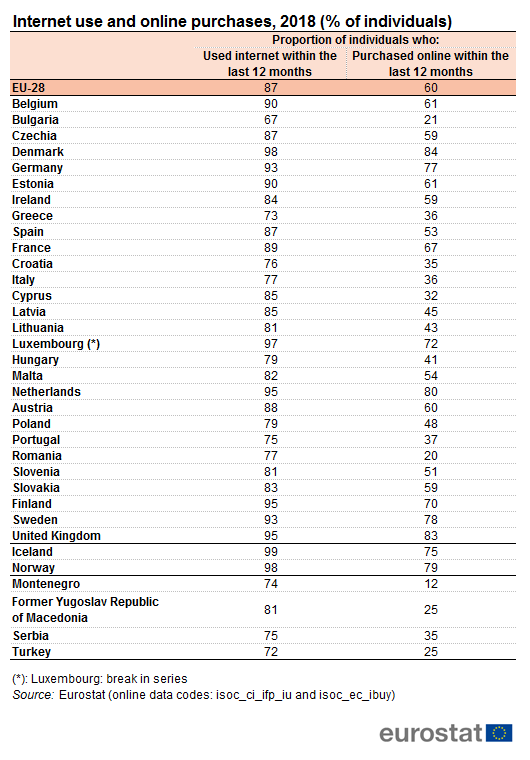
A report authored by Spath (2016) also shows that the UK is among the leading markets for online shopping, followed by Germany, South Korea, the US, and France in that order. World Atlas (2019) gives a different order of assessment by suggesting that American online shoppers are the most active in online shopping, followed by the UK, Sweden, and France. A report by Golob (2017) also affirms the view that the US is the largest market for online shopping sales, followed by China, Japan, India, Germany, and France, in that order (see figure 2 below).
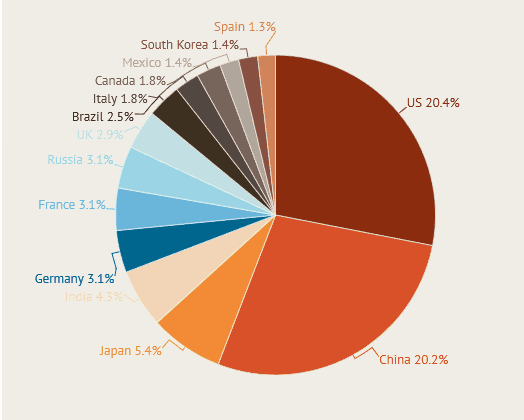
Broadly, the above findings reveal that the US, UK, and China are the leading markets for online shopping.
Barriers to Traditional and Online Shopping
According to Alyami and Spiteri (2015), some international students refrain from shopping for goods online because of the possibility of exposing their personal information. Besides, many international students choose to study abroad to complete their studies. Therefore, they spend a lot of energy on studies, which gives them little “time” to undertake online shopping. Relative to this assertion, Wenjie (2010) said that some students consider online shopping a risky activity, while others deem traditional shopping as a time-consuming venture.
However, the development of online payment systems has encouraged people who are skeptical about online shopping to try it. For example, the Credit card has become one of the most commonly used payment methods among international students (Wenjie 2010).
Traditional shopping is based on the brick-and-mortar business model where customers physically visit a shop and make a purchase. Comparatively, online shopping is based on the principle that a customer can order for a good or service without physically visiting a shop. There are many barriers to both types of shopping models. The first barrier to traditional shopping is its inconveniencing nature (Venkatakrishnan & Loganathan 2018).
In other words, some customers find it difficult to make a physical trip to a shop to make a purchase. Therefore, they may simply choose to order the same item online and have it delivered to them. The time-consuming nature of traditional shopping also undermines its viability because making physical trips to a store is more time-consuming, relative to online shopping. Another barrier to traditional shopping is the inability for customers to compare prices (Alyami & Spiteri 2015). Indeed, visiting one store at a time makes it difficult for customers to know the prices of similar goods in other stores.
Many studies have highlighted different barriers to online shopping. However, delivery costs have emerged as one of the most notable impediments to the growth of this shopping model. This view is supported by Vasić, Kilibarda, and Kaurin (2019) in a Serbian study aimed at investigating the influence of online shopping determinants on customers buying goods online. After sampling the views of 311 participants using a survey, the researchers established that traditional shoppers do not have to pay this extra cost because they receive the goods immediately after purchase, thereby reducing their cost of purchase (Vasić, Kilibarda & Kaurin 2019). Comparatively, many online shoppers have to pay this cost.
Another barrier to online shopping, which has been highlighted by researchers such as Vasić, Kilibarda, and Kaurin (2019) is the lack of knowledge about how to complete online transactions and the lack of access to online infrastructure that would allow shoppers to make a purchase. Concisely, internet penetration rates in some regions are still low, thereby making it difficult for people to take part in e-commerce. Therefore, even knowing online transactions would not help customers because of the lack of infrastructure to execute online transactions.
Summary
This literature review has shown what different researchers have said about online shopping, the nationalities that largely take part in it, and the challenges that characterize traditional and online shopping modes. Many researchers have conducted these reviews using the qualitative method because of their focus on subjective issues such as human attitudes. Although the evidence provided is informative, there is a gap in the literature because no studies have explored students’ attitudes towards online shopping. This study will fill this gap.
Methodology
Introduction
According to Hair (2015), the methodology of a study relates to the processes a researcher undertakes to answer the study questions. This chapter will explore five key issues relating to the methodology adopted in this study. They include the research design, research method, data analysis techniques, ethical considerations, and limitations of the study.
Research Design
The research design for the current study was based on the framework of the mixed method. This model includes the integration of both qualitative and quantitative data. The justification for using this approach stems from the nature of the research aim, which contains both qualitative and quantitative aspects of research. For example, attitude is a qualitative issue, while a determination of the number of students who use online shopping is a quantitative issue. Therefore, the technique of the mixed method provided a holistic framework for assessing all aspects of the analysis.
Research Methods
Data Collection method
As highlighted in this chapter, the researcher collected data using the questionnaire survey method. The questionnaire had two parts. The first one related to demographic information, such as gender and occupation, while the second part contained information relating to the research questions. The questions posed to the students were a combination of open-ended, closed-ended, and multiple-choice questions. Questions 3-7 related to question 1; statements 8-12 related to question 2; and questions 1,2, 13, 14, and 15 related to the second research question. Notably, the questions asked related to the hypotheses listed below.
- More than half of international students have a positive attitude towards online shopping
- Chinese students make the largest number of online purchases.
- Lack of privacy and the time-consuming nature of online shopping are barriers to online and traditional shopping, respectively.
Sample
The researcher recruited informants using random and snowball sampling methods. The random sampling method gives an equal opportunity for researchers to take part in a study. Comparatively, the snowball sampling method involves the recruitment of participants through known contacts. In sum, 55 participants provided information relating to the research questions. However, the researcher initially sent questionnaires to 60 respondents. Therefore, the response rate was 92%. The researcher recruited 42 international students using the random sampling method, while 13 students took part in the investigation after the researcher secured their participation using the snowball sampling method.
Example Questions
The questions posed to the students who took part in the study covered different issues, such as the most convenient payment modes, reasons for using online shopping, how to circumvent the risks of online shopping, disadvantages of traditional shopping, the frequency of online shopping, and advantages of online shopping. The researcher worded the questions as follows: “Present your opinion on online shopping,” “Why do you choose this shopping method?” “What payment method do you usually choose to pay for online shopping?”
Pilot Study
The researcher conducted a pilot study to assess the validity of the questions asked. The pilot study involved 21 students (8 females and 13 males) and revealed that some respondents could not understand the terms used to describe the questions. For example, the use of the term “virtual shopping” was problematic for five informants. Consequently, the researcher replaced it with “online shopping.” The results of the pilot study also revealed that the questionnaire took a short time to complete (less than 3 minutes). Therefore, the researcher increased the number of statements from eight to 15.
Although Veal (2017), Watkins, and Gioia (2015) caution that undertaking a pilot study is not a guarantee that a research project will be successful, the findings of the evaluation helped to increase the likelihood of success in the current study.
Data Analysis
The information that will be obtained using the questionnaire will be analyzed based on how they align with the original three questions guiding the study.
Ethical Considerations
According to Creswell (2014), it is important to observe ethical principles in research to promote fairness and protect the rights of human subjects when participating in research studies. The researcher observed the following ethical considerations in the study.
- Informed Consent: Before participating in the study, the researcher sought consent from the participants. To do so, the researcher furnished the students with information relating to the study, including its purpose and scope. Consequently, they took part in the study voluntarily.
- Right to Withdraw: The respondents were free to withdraw from the study without any repercussions.
- Anonymity: The researcher presented the information obtained from the respondents anonymously. In other words, the researcher did not publish the names and student numbers of the participants.
- Confidentiality: The data obtained from the participants was stored safely and secured using a password. The researcher was the only person with access to this information. Upon completion of the study, the data will be destroyed.
- Health and Safety: The researcher undertook the current study in an institutional setting, which was safe for both the researcher and the participants. Stated differently, the students were free to answer the research questions away from distractions that are often associated with undertaking studies in alternative settings, such as public restaurants.
Limitations of the Study
Time was one limitation of the study. The researcher had to conduct the investigation and submit its results within a limited period, which was fixed by the university’s academic calendar. This limitation affected the number of questions asked and the depth of information the researcher could collect. Another limitation of the study is related to the small sample of participants. Future studies can use a larger group of participants if more resources are available.
Conclusion
This chapter has shown that the methodologies adopted in the study related to the nature of the research aim, which contained both qualitative and quantitative aspects of analysis. The researcher also aligned the data collection instruments with the type of questions asked. In the next chapter, the data obtained from the implementation of the methodological approaches highlighted in this chapter will be discussed.
Findings
As highlighted in this paper, this study aimed to examine students’ attitudes towards online shopping. Data were collected using questionnaires and the findings highlighted in the form of charts and pie charts. The findings of the questionnaire are highlighted below.
Questionnaire Findings
This study was based in LIC and it involved a sample of 55 international students. Twenty of them were females, while 35 of them were male. The respondents were asked to state their preferred mode of shopping and why they would choose it. According to table 1 below, 36% of the respondents said, they used multiple modes of shopping.
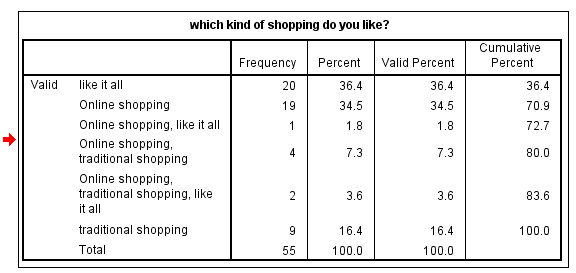
The researcher also asked the respondents to state their main motivations for choosing online shopping and their opinions regarding this mode of purchase. Product quality was the main factor influencing their decisions, while the price of goods was the second most important consideration. Product category and after-sales services were the least notable considerations for taking part in online shopping as seen in table 2 below.
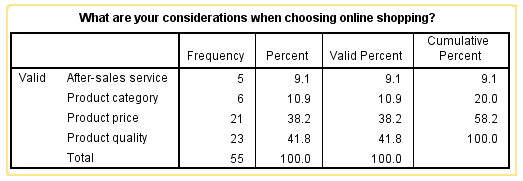
Another question that the researcher asked the students was their thoughts about online shopping defects and their preferred mode of payment. According to table 3 below, Sixty-three percent of the informants said they were concerned that they would not get after-sales service after shopping online. Thirty percent of them also said that online shopping was cumbersome, while five percent of them thought the online payment was unsafe.
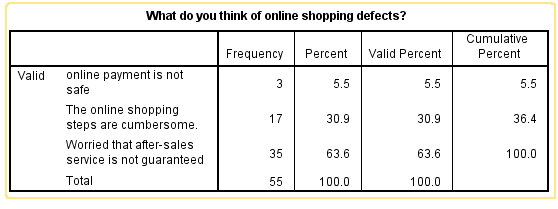
Besides, a majority of the students (40%) stated that they used bank cards to complete online transactions, while PayPal was the second most preferred payment mode (see table 4 below).
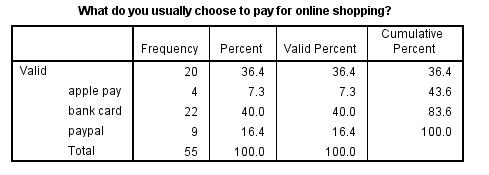
When the researcher asked the respondents to state their views regarding the flaws associated with traditional and online shopping, most of them said that the time-consuming and tedious nature of traditional shopping made it a “waste of time” and an inconvenient way of purchasing goods and services. Comparatively, when the researcher asked the respondents to state the benefits of using online shopping, a majority of them mentioned convenience as being the biggest motivator for using this platform.
The students also deemed online shopping as a cheap and timesaving method of making purchases. When the researcher asked the respondents to state their views regarding customer service, fifty-four percent of them were unsure about whether they would get good customer service through online shopping. Comparatively, only 5% of them agreed that they would get this type of service by buying goods online.
Lastly, the researcher asked the respondents to state how to improve the adoption of online shopping and most of them (38%) believed that an application-based model would yield the best results. Most of the respondents (56%) also said that they shopped online multiple times in one month. Comparatively, about 38% of them said that they shop online once a month, while the smallest group of respondents said they shopped online once a year (see table 5 below).
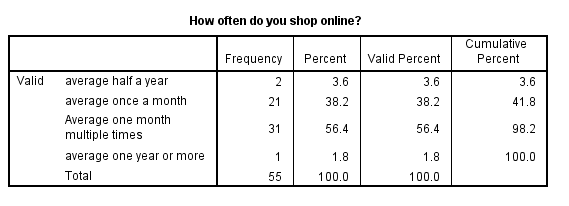
Summary
The findings of this study show that students’ attitudes towards online shopping are shaped by several factors, including their frequency to shop, purchasing power, and trust. These findings could are largely representative of both male and female students because a near equal number of participants from both genders took part in the study.
Discussion
In this section, the researcher evaluated the primary findings highlighted above, relative to the research questions. The sections below show the effects of the findings on the proposed hypothesis and research questions.
Attitude of Students towards Online Shopping
The literature review findings for the first research question showed that most people have a positive attitude towards online shopping (Kibet 2016). Based on this understanding, the researcher hypothesized that more than 50% of international students would have a positive attitude toward online shopping. However, the questionnaire findings opposed the hypothesis because most of the students held neutral views regarding online shopping.
Nationalities with the Highest Frequency of Online Shopping
The findings derived from the literature review showed that Americans were the leading customers for goods and services bought online (Golob 2017). Alternatively, the proposed hypothesis suggested that Chinese students are more active in online shopping compared to other international students. The questionnaire findings supported the hypothesis because Chinese students reported the highest frequency of shopping online.
Barriers to Traditional and Online Shopping
Findings from the literature review section showed that the time-consuming nature of traditional shopping and the shipping costs undermined the viability of online shopping (Vasić, Kilibarda & Kaurin 2019). Alternatively, the proposed hypothesis suggested that the biggest barriers to online and traditional shopping for LIC students were privacy and time, respectively. However, the questionnaire findings disapproved of the hypothesis because pricing and quality issues emerged as the most significant barriers to traditional and online shopping.
Limitations of the Study
The current study was limited to international students who studied at LIC. Therefore, the findings are representative of this group of students. Time was also another limitation of the study because the researcher had to undertake the project within the university’s academic calendar.
Summary
Based on the findings highlighted in this study, the perception of international students towards online shopping emerged as a product of several factors, including security, trust, and convenience. These insights show that the attitude of international students towards online shopping is dependent on how well the shopping platform integrates with student life.
Conclusion and Recommendations
The current study was guided by three key questions, which sought to find out the number of international students who have a positive attitude towards online shopping, the nationality of students who make the largest number of online purchases, and the barriers that exist in traditional and online shopping for LIC students. The evidence gathered in the analysis showed that most students held a neutral view regarding online shopping and Chinese students emerged as being the most active users of online shopping platforms at LIC. The time-consuming nature of traditional shopping and the extra costs associated with online shopping also emerged as impediments to the growth of both shopping platforms.
Future research should investigate these findings in-depth because the views expressed in this study are largely indicative. For example, researchers should explore why Chinese students emerged as the most active online shoppers compared to other nationalities at LIC. Similarly, future studies should expand the scope of this study by including a larger sample of students from other universities to have a broader understanding of students’ perceptions regarding online shopping.
Reference List
Al-Debei, M, Akroush, MN & Ashouri, MI 2015, ‘Consumer attitudes towards online shopping: the effects of trust, perceived benefits, and perceived web quality’, Internet Research, vol. 25, no. 5, pp.707-733.
Alyami, E & Spiteri, L 2015, ‘International university students’ online shopping behaviour’, World Journal of Social Science, vol. 5, no. 3, pp. 227-243.
Creswell, JW 2014, Research design: qualitative, quantitative, and mixed methods approach, SAGE, New York, NY.
Dani, NJ 2014, ‘A study on consumers’ attitude towards online shopping’, International Journal of Research in Management & Business Studies, vol. 4, no. 3, pp. 42-46.
Eurostat 2019, E-commerce statistics for individuals. Web.
Golob, P 2017, Who tops the big 15 e-commerce markets in 2017 – China or US?. Web.
Hair, JF 2015, Essentials of business research methods, M.E. Sharpe, New York, NY.
Kibet, KA 2016, A study of consumer behaviour towards online shopping in Kenya: case of Nairobi County. Web.
Kitonyi, N 2017, UK online shopping and e-commerce statistics for 2017. Web.
Nabot, A, Garaj, V & Balachandran, W 2017, ‘Consumer attitudes toward online shopping: an exploratory study from Jordan’, Mobile Commerce: Concepts, Methodologies, Tools, and Applications, vol. 3, no. 1, pp. 1110-1123.
Spath, D 2016, Countries with the most online shoppers. Web.
Statista 2018, E-commerce in the UK – statistics & facts. Web.
Statista 2019, E-commerce worldwide – statistics & facts. Web.
Vasić, N, Kilibarda, M & Kaurin, T 2019, ‘The Influence of online shopping determinants on customer satisfaction in the Serbian market’, Journal of Theoretical and Applied Electronic Commerce Research, vol. 14, no. 2, pp. 70-89.
Veal, AJ 2017, Research methods for leisure and tourism, 5th edn, Pearson UK, London.
Venkatakrishnan, S & Loganathan, NG 2018, ‘The consumer behaviour towards online shopping in Coimbatore city-an exploratory study’, International Journal of Pure and Applied Mathematics, vol. 120, no. 5, pp. 1459-1489.
Watkins, D & Gioia, D 2015, Mixed methods research, Oxford University Press, Oxford.
Wenjie, X 2010, ‘A empirical study on influencing factors to college students‘online shopping’, International Conference on Computer and Automation Engineering (ICCAE), vol. 5, no. 1, pp. 612-615
World Atlas 2019, Countries who spend the most money shopping online. Web.